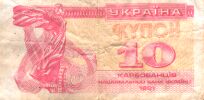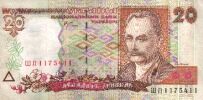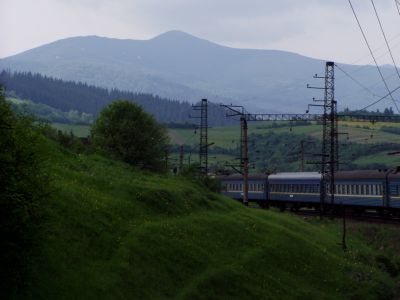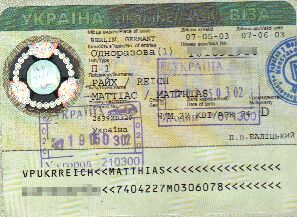Prologue
Spring 2003 and it was time to hit the road again: To boldly go... This time it shouldn't be Asia but a comparatively close destination - the Ukraine. Everyone knows more or less exactly, where this country is located. Everyone has heard of Kiev, the Crimea and not to forget Chernobyl. As for the image of the Ukraine in Europe, it must be a place full of chaos, mismanagement, car dealing mafia and so on. Strange enough, no one really seems to know more about the country. What is true about all the rumours? Is this country, only 16 hours away from Germany by train, really such a terrible place? And what is "Ukrainian"? Is it just a Russian subculture? Or something completely different? How is the country going after the breakdown of the USSR and Chernobyl? And why are there almost no tourists at all heading for the Ukraine (ok, this seems to be changing)??? Additionally to a genuine interest in other cultures, history and beautiful landscapes, these questions and the fact, that a good friend of mine was working in the Ukraine at that time, had driven us to the Ukraine. To come to the point - we didn't regret it once.
Money

| 
|
|
|
After years of galloping inflation right after declaration of independence, the Ukraine managed to stabilize their currency Hryvnia. At first, a temporary currency called Karbowanzi was in use. In 1992, the Karbowanzi were replaced by today's currency. 1 Hryvnia consists of 100 Kopinok. There are 1, 2, 5, 10, 25 and 50 Kopinok coins and 1, 2, 5, 10, 20, 50 and 100 Hryvnia bills circulating. Be aware that there are two versions of all bills - an old and a new one. Both are accepted.
Numerous ATM's accepting all major credit cards and also 'maestro'-cards etc. can be found in all bigger cities. Usually there is a fee around € 4 for each transaction, but it must be said that exchange rates at ATM's are usually much better than at one of the countless exchange booths. It remains a mystery to me that the rate at exchange booths in →L'viv is everywhere the same and considerably worse than in other cities of the country. It's possible to pay with your credit card in bigger shops and restaurants, but I wouldn't rely on that.
According to rumours, credit card fraud is quite common. This can be done through manipulation of ATM terminals. True or not - to avoid any trouble, it's not a bad idea to rely on ATM's inside bank buildings during business hours. However, I'd withdrawn money from ATM's outside bank buildings as well and never had any trouble.
Costs
Traveling the Ukraine is comparatively cheap - cheaper then any other destination west of the Ukraine (except Moldova). Even long distance trains are very cheap - in 2003, a 1,000 km train ride was only around 10 USD. There is no real low-budget accommodation for travelers, but many smaller hotels are by definition already low-budget. As with Russia, it's not a big problem to get by on 20 to 30 USD a day, but it's also very simple to burn a lot of money - there's luxury, from hotels to restaurants and shops, available in all larger towns. Needless to say that the capital is more expensive then the rest of the country.
Getting there
In contradiction to other CIS states such as →Georgia, →Armenia or →Moldova, the area around the Ukraine is relatively quiet and safe, and so it's no problem at all to enter the Ukraine. There are several border crossings to Russia for trains, cars and, in summer, ferries. From Kiev, trains head for Moscow, St. Petersburg, Woronyesh, Adler (near Sochi at the Black Sea coast) and more destinations in Russia. Be aware that almost everyone needs a visa for Russia, which cannot be obtained at the border.
The same can be said about the northern neighbour →Belarus: Several train and road border crossings exist, but everyone needs a visa which won't be issued at the border.
There are some trains from destinations in →Poland, mostly from →Warsaw but also from Krakow and Lublin. It's not unproblematic to enter the Ukraine from Poland by car. Not seldomly, there's a large queue at the border. You can often buy a better position in the queue from the local mafia (no kidding!).
There are two border crossings to →Slovakia. One is for the road near →Uzhgorod; another one for the train near Chop. The international train from →Kosice to Kiev. crosses here. Bribes seem to be quite usual, however, as pedestrians we didn't encounter any problems at the border. The queue was rather short, too. Most nationalities (probably except Australians) do not require a visa for Slovakia.
Also near Chop, which is actually a small city between three countries, there's another crossing to neighbouring →Hungary for trains and cars. One train runs from Kiev to →Budapest. Most nationalities don't need a visa for Hungary.
South of the Carpathians, there's one border crossing to →Romania for all kinds of transport direction Bacau. Most nationalities don't need a visa for Romania. There are more border crossings to Romania, but this one between Chernivtsi and →Suceava seems to be the only one open to foreigners. Attention: There's no Ukrainian-Romanian border crossing south of Moldova in the Danube delta!!!
Numerous border crossings lead to the western neighbour, the Republic of →Moldova. There are several things travellers should be aware of:
- 1. Almost everyone needs to obtain a visa beforehand (see below)
- 2. Some domestic Ukrainian trains (e.g. from Chernivtsi and Reni to Odessa) cross the territory of Moldova. Travellers will be in trouble without a transit visa!
- 3. The small stretch between the Ukrainian border and the river Dnestr is claimed by the renegade republic →Transnistria (PMR) (capital is →Tiraspol). Since Transdniestr's independence is not recognised at all, there's no visa (but you still need a Moldovan visa if you want to enter from the Ukraine!). When coming from the Ukraine, chances are high that you will pay a hefty bribe at the border. There's a direct train from →Odesa to →Chisinau (Kischinow), but this train stops in Tiraspol. I'm not sure if it's more unproblematic by train.
There's a direct train from Germany (to be more exactly from Berlin-Lichtenberg) once a day to Kiev. Some carriages even continue to →Simferopol. The train leaves Berlin at 21:42 and goes all the way via Frankfurt/O., Warsaw, Lublin and Kovel to Kiev, where it arrives 25 hrs later at 23:45 (local time) in Kiev. The train arrives at the Ukrainian border at 1 p.m. (1 hour time difference, Poland is GMT +1, Ukraine +2) . There, the train stops inside a huge hall for two hours to change the wheels so that they fit the wider Ex-Soviet Union gauge (Stalin was afraid that his country might be invaded by train!). In contradiction to other entry points such as →Brest in Belarus, it's not allowed to leave the train during the procedure. The full fare for a single ticket for this train is about € 100, which includes the € 22 for the sleeper berth (all carriages are sleeper berths). The train itself is rather new with three beds in each compartment. With the result, that there is less space than in the old Soviet carriages.
Getting around
Travelling the Ukraine means, unless you bring your own car or spend most of your travel time above the clouds, excessive train rides. The Ukraine is quite a big country, and so it takes many hours to cover the distances. The country runs an extensive railroad network with trains operating round the clock. long-distance trains often need more than 12 hours, which is why many of them run at night.
Train tickets are to be purchased at the ticket counter (says Confucius), but: Not every ticket counter is good. There are counters for pensioners, handicapped people, families with children and so on. Furthermore all counters close from time to time, but these times are usually specified. The people behind the counter can be pretty hostile - some of them will make you understand that you as the customer are nothing else than a disturbing element.
Everyone (incl. Ukrainians) needs a passport to buy a ticket! The name given in the passport is printed on each ticket, which is why staff mostly look for the visa first, since the visa states the passport holder's name in cyrillic letters. It is not possible to buy train tickets shortly (one, two hours) before departure - it's safer to buy it one day in advance.
There are no regular seats in long-distance trains. Instead, you can choose between between 'kupe' and 'platskartnyi' (deriving from the German word 'Platzkarte' which stands for 'seat reservation'). A kupe is a compartment with four beds - two lower and two upper beds. There's plenty of space to store the luggage above the door and below the beds. The latter is like a chest - when you sleep in the lower beds, you sleep atop your luggage, so it's almost impossible for everyone to have access to your luggage. It's not possible to open the window inside the compartment, but with some luck the air condition is working. There's also a small table inside the compartment. Of course, Kupe is slightly more expensive but compared to other countries still extremely cheap.
The cheaper one is called platskartnyi. They consist of four-bed compartments as well, but there are no walls and doors between the compartment. There's an aisle through the entire carriage with two narrow beds opposite the small compartments above the window. Now what does that mean? Platskartnyi carriages are narrow, noisy, often overcrowded and - that is the biggest problem - incredibly hot, when it's warm outside. In both types of carriages, bed linen cost an extra fee - at least it includes a towel. The price is around € 1. Use the cushion and the blanket without buying the bed linen, and the conductor can get really nasty!

| ||
| On the train through the Forest Carpathians |
Talking about conductors (often called dezhurnaya/dezhurnyi): Every coach has one, man or woman (mostly women). Some of them are nasty old dragons, others get friendly during the journey and a few are nice from the beginning. Their job is not really enviable: Tasks include running through the carriages to lock and open the toilets before and after each train stop (so that passengers don't use it while in train stations) and fighting drunken passengers. Conductors sell tea and coffee until one hour before the last stop. The price for a hot drink is usually around € 0.15 - it's a good idea to have lots of small money, because some of them won't give you the change no matter how much you've given to them. Better buy a hot drink when the conductors are running around offering them, because it's only then that you can be sure that the water is really hot and not just tepid. When passengers board the train, conductors check everyone's ticket and passport to make sure that the name in the passport and the name stated on the ticket are the same. I.e. no passport = no train ride. Conductors then keep the train ticket and give it back shortly before the arrival. Hence it's simply impossible to miss the station (very convenient!).
Every carriage has a toilet. Dirty or not - this depends on your conductor. Sometimes the toilet is spotless clean, but more often it's a dirty, filthy place. The reason is quite simple - many Ukrainians step onto the toilet seat to sh**. Why is that, I asked. 'Well, because the toilet seat is dirty!' someone answered. Which it wouldn't be if people wouldn't step on it! Don't count on toilet paper, better bring your own. And now the secret of the flowing water: Behind the tap above the wash-basin, there's a small metall pin stuck to the underside. Just push the pin upwards and that's it. The pin is not visible when you stand in front of it, and so there's almost no chance to find it out by yourself.
All long-distance trains either have a complete restaurant coach or something like a buffet. Don't rely on buffets - they close whenever they want, and so you might find yourself being stuck in a train for 15 hours without any food. On the other hand, restaurants are really good and very convenient. They sell proper food, snacks, alcoholic (of course!) and soft drinks, tea and coffee etc., for reasonable prices. Fancy a smoke? You can do this in every train between the carriages. It's not allowed to smoke in compartments or in the aisle.
Visa information
Attention: All information about visa requirements as written below is as of 2003 - check with your local Ukrainian embassy if you are not sure. The Ukraine has made agreements with several countries regarding more relaxed immigration procedures, so by the time you read this, you might not longer need a visa to enter the country! Help your fellow travelers by posting new visa /entry regulations using the comment function at the bottom of this page!
(As of 2003:) Except for CIS citizens (probably) almost every one needs a visa. As far as I know, there's no way to obtain a visa upon arrival. Therefore it's necessary to arrange everything ahead. Every Ukrainian embassy will do. Usually it takes around 5 or 6 working days when you pick it up by yourself at the embassy. It might need around three or four weeks when you send everything by mail.

| ||
| Ukrainian Visa |
There are different types of vias - business, tourist, transit and private visa. The easiest to get is the private visa, since you'll need vouchers to get a tourist visa. Don't panic - it's much easier to get a visa for the Ukraine than for instance for Russia or Belarus. All you need is the following paperwork:
- A valid passport with several months validity left.
- A visa form. It's not necessary to consult companies offering visa support to get a private visa! You will notice that you are asked for a contact address in the Ukraine. This address will not be checked! Just pick out a valid address, and that's it. You don't even have to show up at the address given. You can travel around freely without registering with local authorities.
- Quite unusual is the fact, that everyone needs a separate health insurance which covers the entire length of the stay in the Ukraine. In some countries, it must be a health insurance from a specific company - request information at the embassy! As for Germany, the health insurance valid for the Ukraine costs € 20 for one month. In some countries, it's not possible to obtain a visa without the confirmation of the health insurance. If you don't have one, you'll have to buy one upon arrival. The price for three weeks is around € 13.
- You will also need the deposit slip for the visa fee. A regular private visa good for one entry and valid one month costs € 50 for Germans (probably around the same for other nationalities) + € 10 if you want to get it by mail. BTW - Japanese need a visa, too, but it's for free! This isn't fair!!! It's not a good idea to exceed the visa - you cannot even buy a train ticket without having a valid visa.
Vic wrote:
HI there,
The information here is obsolete.
You don't need visa if you are eu/us citizen - you can be in the country for 1-3 month (don't remember how long exactly) and every train ticket can be bought without the passport (since 2007/2008 I guess).
Good luck. :-)
Posted by Vic on March 29, 2009 02:18
©2024 Europe-East.com

 Albania
Albania Ukraine
Ukraine